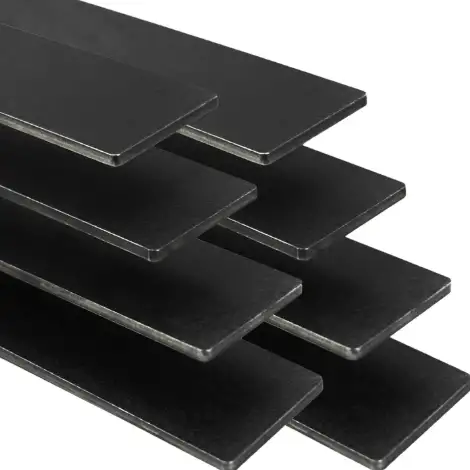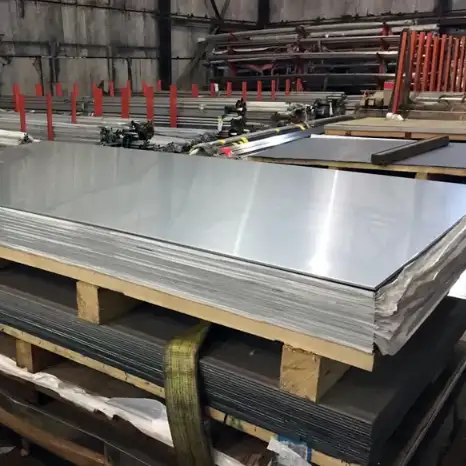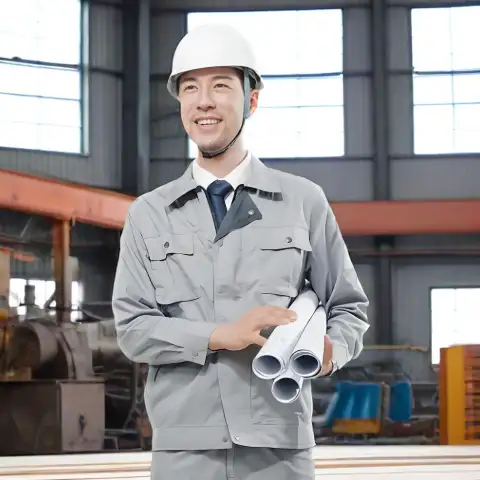If you need raw toughness, simple predictable heat-treat behavior, excellent impact resistance and easy field sharpening for heavy-duty cutting or chopping tools, 1095 high-carbon steel is usually the better choice. If you need higher corrosion resistance, superior wear/edge-holding at high hardness and a stainless finish for low-maintenance environments, 440 (notably 440C) is typically preferable. Both are inexpensive, readily available steels with clear trade-offs: 1095 sacrifices corrosion resistance for toughness and simplicity; 440C trades some toughness for hardness, wear resistance, and stainless behavior. Choose based on environment, intended abuse level, restoration/maintenance plans, and heat-treatment capability.
1095 High Carbon Steel vs. 440/ 440C Stainless
-
1095 — A plain high-carbon steel (~0.95% C) with minimal alloying (low chromium). Readily hardened to moderate/high hardness with predictable quench/temper cycles; excellent toughness for a high-carbon steel but not stainless (prone to rust without protection). Used extensively in traditional knives, swords, springs and basic cutting tools.
-
440 (440A/440B/440C) — A family of martensitic stainless steels; 440C is the high-carbon member (~0.95–1.1% C) with ~16–18% Cr, capable of taking very high hardness and offering substantially better corrosion resistance than 1095 while keeping good wear resistance. 440A and 440B are lower-carbon variants balancing corrosion and hardenability.
Chemical composition
| Element / Grade | 1095 (typical) | 440A (approx.) | 440B (approx.) | 440C (approx.) |
|---|---|---|---|---|
| Carbon (C) | ~0.90–1.00% | 0.60–0.75% | 0.75–0.95% | 0.95–1.20% |
| Chromium (Cr) | ~0.25–0.40% | ~16% | ~16% | ~16–18% |
| Manganese (Mn) | ~0.3–1.0% | ~1.0% | ~1.0% | ~1.0% |
| Silicon (Si) | ~0.2–0.4% | ~1.0% | ~1.0% | ~1.0% |
| Sulfur / Phosphorus | Low | Varies (440F adds S) | — | Low |
| Other (Mo, V) | Trace | Trace (sometimes Mo, V small amounts) | Trace | Sometimes small Mo for deep hardening |
Notes: Exact chemistries vary by producer and spec. 440C’s high chromium makes it stainless and enables carbides that increase wear resistance; 1095’s near-1.0% C yields more martensite potential but almost no stainless protection.
Metallurgy and microstructure
-
1095 is essentially a carbon steel. Its microstructure after quench/temper is primarily martensite plus some retained ferrite/pearlite depending on thermal path. At ~0.95%C, abundant free carbon forms hard martensite and sometimes large carbides if processing is aggressive; this gives high hardness and good edge retention but also brittleness if over-hardened or improperly tempered.
-
440C is a martensitic stainless—chromium in the 16–18% window supplies corrosion resistance by forming a passive Cr₂O₃ film. The high carbon level forms hard chromium carbides (M₇C₃/M₂₃C₆ types depending on exact chemistry and cooling), producing excellent wear resistance. Because it's stainless, surface oxidation (rust) is strongly reduced compared to 1095.
Key engineering takeaway: carbides improve wear and edge holding but reduce toughness; chromium trades toughness for corrosion resistance and wear hardness.

Mechanical properties and practical hardness ranges
| Property | 1095 (typical, heat-treated) | 440C (typical, heat-treated) |
|---|---|---|
| Typical hardness (Rockwell C) | 56–62 RC (dependent on tempering) | 57–62 RC (440C can exceed 60 RC in aggressive treatments) |
| Tensile strength | Moderate to high (varies with heat treat) | High after quench/temper |
| Toughness | Higher relative toughness (less brittle than highly hardened stainless) | Lower toughness at same hardness due to carbides |
| Corrosion resistance | Poor — will rust without protective finish | Moderate to good — “stainless” in many environments |
| Wear/edge retention | Good (if hardened) | Better — carbides + high hardness improve wear resistance |
Practical note: heat treatment recipe and section thickness strongly influence these numbers; 440C requires careful heat-treat control to avoid cracking but reaches very high hardness and wear resistance when done correctly.
Heat treatment: recipes and tips (knife/tool-maker perspective)
1095 (oil-quenched route for knives):
-
Normalize at 800–830 °C (1475–1525 °F) (one or two cycles).
-
Austenitize at 780–820 °C (1435–1510 °F) depending on grain control.
-
Quench in oil (fast enough to form martensite but slow vs water to reduce cracking).
-
Temper: common double temper at 200–250 °C (390–485 °F) for a balance of hardness/toughness; higher temps (350–450 °C) lower hardness for tougher blades. Typical final hardness 56–60 RC for many knives.
440C (furnace/hardening shop route):
-
Solution anneal if supplied in annealed condition.
-
Austenitize higher than 1095: 1000–1040 °C (1830–1900 °F) for adequate carbide dissolution and hardenability.
-
Quench in oil; because of high Cr and carbides, quench control is critical — parts may require subzero treatment (optional) to reduce retained austenite.
-
Temper at moderate temps to reach desired hardness—final hardness often 58–62 RC for cutting edges used in knives.
440C can be more prone to cracking during aggressive quenching or temper cycles; professional heat-treat control or outsourced heat treat is common for high performance stainless blades. 1095 is more forgiving in small sections but will rust without coatings.

Corrosion resistance
-
1095 — Expect visible rust in humid or salty environments unless the steel is oiled, painted, parkerized, or kept very dry. Even polished 1095 oxidizes readily. For outdoor knives that will see moisture or bodily fluids, plan on regular maintenance (oil, dry storage).
-
440C — Much better resistance under normal conditions (kitchen, mild outdoor use), but not immune: in highly saline or acidic conditions, stainless can still pit if protective film is damaged and left wet. For marine use, higher alloyed stainless (e.g., 154CM, CPM-S30V, 316) or coated steels may be chosen.
Edge retention, wear resistance, sharpening
-
Edge retention depends on hardness, carbide distribution and microstructure. At comparable hardness, 440C typically holds an edge longer than 1095 because of hard chromium carbides. However, on a per-impact basis, 1095’s greater toughness helps it resist chipping under heavy abuse. Blade forum and metallurgist tests corroborate this practical tradeoff in many field reports.
-
Sharpening: 1095 tends to be easier to re-profile quickly in the field using stones because it forms a more ductile burr; 440C is harder and sharper-holding but needs more effort and coarser abrasives to reshape. For users who re-sharpen in the field frequently, 1095 can be friendlier.
Typical applications
Choose 1095 when: large outdoor blades (machetes, survival choppers), traditional straight razors and historical reproductions, tools where toughness and predictable simple heat-treat matter more than corrosion resistance, and when cost/repairability is prioritized.
Choose 440C when: small to medium knives needing stainless behavior (kitchen knives, folding pocket knives), bearings or valve parts where wear and some corrosion resistance are important, applications where a stainless finish reduces maintenance.
Manufacturing implications: forging, machining, welding, and inspection
-
Forging: 1095 forges readily and is popular for hand forging. 440C is harder to forge because carbides and chromium increase work hardening; many shops machine 440C from bar stock or use vacuum forging followed by controlled heat treat.
-
Machining: Annealed 440C machines okay, but when hardened it's abrasive; 1095 in annealed state machines readily but becomes tough post-heat treat. 440F (free machining) exists for easier production.
-
Welding: 1095 is weldable with preheat/postheat protocols but is not easy due to high carbon (risk of hard brittle HAZ). 440C welding is difficult and often discouraged; stainless filler metals and specialized procedures are used if necessary. Always consult a welding engineer for critical work.
Decision matrix: how to pick
-
Environment wet / salty? → Prefer 440C (or higher stainless).
-
Heavy chopping/impact? → Prefer 1095.
-
Want lowest maintenance? → 440C.
-
Need easy field re-sharpen? → 1095.
-
Want maximum edge retention for fine cutting? → 440C (if heat-treated and tempered appropriately).
-
Cost sensitivity + simple supply chain? → 1095 is usually cheaper and widely available.
Care & maintenance
For 1095: keep oily or waxed if stored; after use in wet conditions, dry and oil blade; consider protective coatings (kept, parkerizing, bluing, or modern DLC) for high-use items.
For 440C: wipe dry and clean; occasional light oiling still recommended for long service life in marginal environments. 440C is low-maintenance but not maintenance-free.
Standards, testing, and quality control
-
1095 is commonly referenced in SAE/AISI 1095 / UNS G10950, with equivalents listed in EN/DIN catalogs (useful when sourcing internationally).
-
440C is a standard stainless grade (UNS S44004 / W.Nr. 1.4125) with datasheets and supplier PDFs (hardening ranges, machinability, typical applications) that describe expected properties. For production parts, request material test certificates (MTCs), hardness profiles, and micrograph documentation where appropriate.
1095 high carbon steel vs 440 stainless Comparison tables
A — Quick pros / cons
| Grade | Pros | Cons |
|---|---|---|
| 1095 | Tough, easy to forge, excellent impact resistance, easy field sharpening, low cost | Rusts easily, needs coatings/maintenance, lower wear resistance than stainless carbides |
| 440C | Stainless, excellent wear/edge retention, high hardness achievable, low maintenance | Lower toughness at high hardness, harder to heat-treat and weld, may be pricier to process |
B — Use-case mapping
| Use case | Better pick | Why |
|---|---|---|
| Hunting knife (blood, wet) | 440C (or other stainless) | Reduced corrosion; easier hygiene |
| Bushcraft chopper | 1095 | Toughness and easy re-profiling |
| Kitchen folding knife | 440C | Stainless + edge holding |
| Large survival machete | 1095 | Toughness and simplicity |
Realistic performance anecdotes from makers & metallurgists
Field testing by makers, knife forums and metallurgists consistently highlight the same practical points: 1095 will accept a very tough edge and will resist chipping under heavy impact; 440C will keep a keener, longer-lasting edge for slicing tasks and requires less day-to-day protection from corrosion. These community reports align with technical datasheets and supplier literature.
Final selection checklist
-
Rate the operating environment (dry, wet, salty).
-
Rank expected loading (impact vs slicing).
-
Decide on maintenance willingness (regular oiling vs none).
-
Confirm heat-treat capability (in-house or outsourced).
-
Choose 1095 for toughness and reparability; choose 440C for stainless and wear.
FAQs
Q1: Is 1095 better than 440C for bushcraft?
A: For bushcraft involving batoning, heavy impact and field sharpening, 1095 often performs better because of higher toughness; however, if you expect a lot of wet conditions and want less maintenance, 440C is preferable.
Q2: Will 1095 rust in a kitchen?
A: Yes. 1095 is not stainless. In a kitchen environment it will rust if left wet or not oiled; for food use consider stainless variants like 440C or higher-alloy stainless.
Q3: Which steel holds an edge longer — 1095 or 440C?
A: When both are hardened to similar Rockwell values, 440C generally holds an edge longer because of hard chromium carbides, though real performance depends on heat treat and geometry.
Q4: Can I weld 1095 or 440C?
A: 1095 can be welded with proper preheat/postheat; 440C is difficult to weld and usually avoided; consult welding specs for each application.
Q5: Which is easier to sharpen in the field?
A: 1095 is easier to reprofile with stones in the field due to its relatively more ductile burr characteristics.
Q6: Are 440C knives brittle?
A: 440C can be more brittle at very high hardness compared with 1095; correct tempering and edge geometry reduce chipping risk.
Q7: What hardness should I aim for?
A: For knives: 56–60 RC for 1095 (balanced). For 440C: 58–62 RC for strong wear resistance (but adjust for intended use).
Q8: Is 440B better than 440C?
A: 440B sits between 440A and 440C; it trades some hardness/wear for slightly improved corrosion resistance and machinability. 440C is chosen when maximum hardness/wear resistance is desired.
Q9: For bearings and wear parts, which is better?
A: 440C due to high hardness and chromium carbides, 440C is commonly used in bearings, valve parts and wear components where corrosion resistance plus wear resistance are needed.
Q10: Where can I find official specs and test sheets?
A: Use authoritative datasheets from suppliers (e.g., Rolled Alloys, Atlas Steels), AISI/SAE and standard reference portals for UNS/AISI numbers and heat-treat guidance. See the curated list below.

